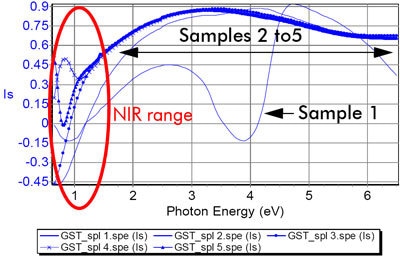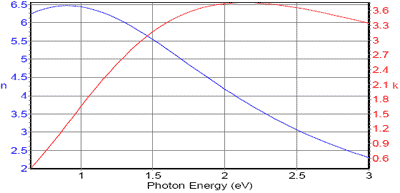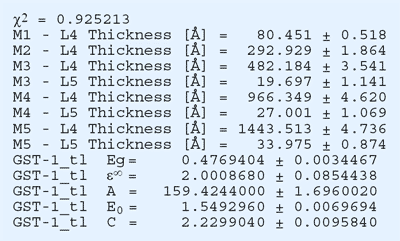Sponsored by HORIBAApr 19 2007
Phase change optical recording is a challenging technology for data storage that is used for CD and DVD rewritable discs. It is based on localized laser induced heating of a thin layer to cause a phase transition from the crystalline to amorphous state. This transformation results in optical reflectance differences. Currently phase change rewritable optical discs are mainly based on two families of phase change materials.
Pseudo-binary alloys based on GeTe-Sb2Te3 (here referred to as GeSbTe) or quaternary AgInSbTe alloys. The choice of material is governed by the specific requirements of the application. An accurate measurement of the thickness and optical constants of the multilayer system is important because mechanical, optical and thermal characteristics are influenced by the entire layer structure. Spectroscopic ellipsometry allows the simultaneous determination of these properties quickly and with high accuracy.
GeSbTe Material
GeSbTe, or Germanium-Antimony-Tellurium, is a phase change material from the group of chalcogenide glasses used in rewritable optical discs and phase-change memory applications. It is a ternary compound of germanium, antimony, and tellurium, with composition GeTe-Sb2Te3. Its recrystallization time is around 20 nanoseconds, allowing writing bitrates of up to 35 Mbit/s, and direct overwrite capability up to 105 cycles. During writing, the material is first erased by conversion to its crystalline state by heating it to its crystallization temperature using relatively long, low intensity laser irradiation. After this information is written onto the crystalline phase by heating with short (<10 ns), high-intensity laser pulses. The material locally melts and is quickly cooled, remaining in the amorphous phase. As the amorphous phase has lower reflectivity than the crystalline phase, the bitstream can be recorded as “dark” amorphous spots on the crystalline background.
Experimental
The work was performed using a UVISEL NIR Spectroscopic Phase Modulated Ellipsometer. The ellipsometric measurements were made at an angle of incidence of 75° across the spectral range 0.65-6.5 eV (190 – 1907 nm). The analysis was carried out in the restricted spectral range 0.65-3 eV. The NIR range is especially useful for this type of analysis as it contains the most precise information for characterizing the GeSbTe material. Five different samples with increasing thicknesses of GeSbTe were characterized. The samples are composed of the phase-change layer containing a GeSbTe alloy deposited onto a dielectric layer of SiO2, the substrate is c-Si.
It is important to notice that the dielectric layer was deposited on both sides of the substrate. As the measurement was performed in the NIR range, it is necessary to take into account the back SiO2 layer in the model because in this range the c-Si is transparent and consequently the backside reflections were collected during the experimental measurement.
Analysis Of The Experimental Spectra
- The NIR range is sensitive to the presence of the back coating of SiO2.
- Sample 1 exhibits interference fringes in the visible as it has the thinnest GeSbTe thickness. These fringes are due to the SiO2 layer.
- Samples 2 to 5 exhibit the same experimental data in the visible and FUV range. Therefore we can conclude that the NIR range contains the most important information to analyze the different GeSbTe structures.

Figure 1. Experimental data of the 5 GeSbTe samples
Characterization of the Multilayer System
Analysis of 5 Samples
The model below has been used to fit perfectly the five samples from 0.65 to 3.0 eV. Note that the model includes a rough overlayer on top for the samples 3 to 5. The rough overlayer is modeled by a mixture of 50% void + 50% GeSbTe using the effective medium model approximation.
Table 1. Sample model
|
Roughness
|
~50Å
|
|
GeSbTe
|
~70< d <1450Å
|
|
SiO2
|
~1000Å
|
|
Glass substrate
|
~300 μm
|
|
SiO2
|
~1000Å
|
The Tauc Lorentz oscillator formula was used to model the optical constants of the GeSbTe layer. The varying parameters during the fitting process were the GeSbTe film thickness and optical constants. The χ² represents the goodness of fit parameters. The table below summarizes the results obtained by spectroscopic ellipsometry analysis for the five samples.
Table 2. The results obtained by spectroscopic ellipsometry analysis for the five samples
|
|
|
|
|
|
|
1
|
1008
|
72 ± 4.386
|
/
|
0.14
|
|
2
|
1028
|
315 ± 22.125
|
/
|
0.47
|
|
3
|
1038
|
450 ± 3.282
|
38 ± 1.779
|
0.14
|
|
4
|
1042
|
935 ± 4.182
|
43 ± 1.555
|
0.20
|
|
5
|
1045
|
1390 ± 5.451
|
60 ± 2.025
|
0.26
|

Figure 2. Optical constants of GeSbTe - sample 4
Multiple Sample Analysis
These five samples include the same GeSbTe layer and optical constants, but have different thicknesses. As a result the analysis of all samples may be performed simultaneously using the same GeSbTe optical constants coupled across the five models. The report below presents the analysis results for the five models (called M1 to M5). One set of optical constants has been determined in addition to the thickness of each film. As expected the uncertainty between the analyses is found to be larger for the first two samples. The multiple sample analysis has the advantage of reducing the parameter correlations and error bars, especially for samples 1 and 2.

Figure 3. Analysis results for the five models (M1 to M5)
Conclusion
Spectroscopic ellipsometry is a powerful technique for high accuracy characterization of the thickness and optical constants of GeSbTe multilayer systems for rewritable optical disc applications.
It was shown that measurement in the NIR range gives better accuracy for the analysis of these types of material. The use of the multiple sample analysis reduces parameter correlations and errors for the thinnest layers.
Owing to the advanced modelling features included in the DeltaPsi2 software, it is a straightforward procedure to analyze such structures even with layers deposited on both sides of the substrate.

This information has been sourced, reviewed and adapted from materials provided by HORIBA.
For more information on this source, please visit HORIBA.